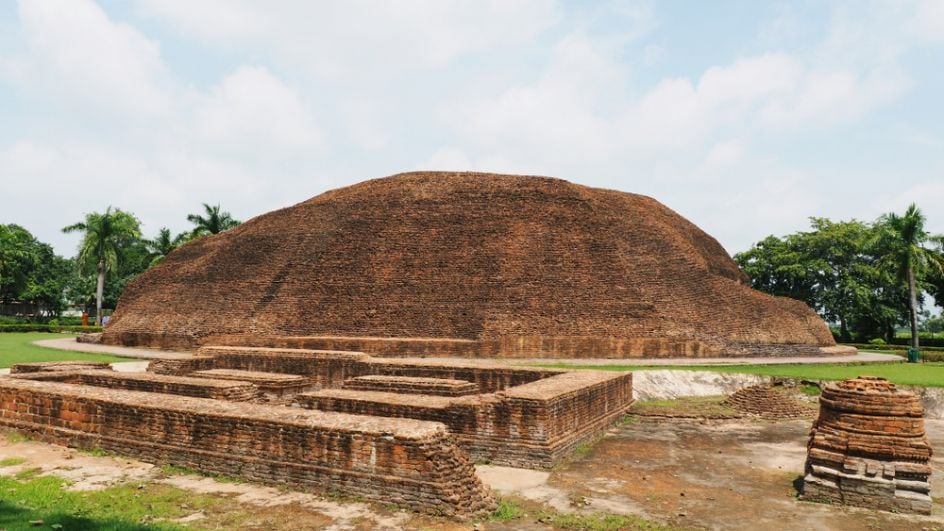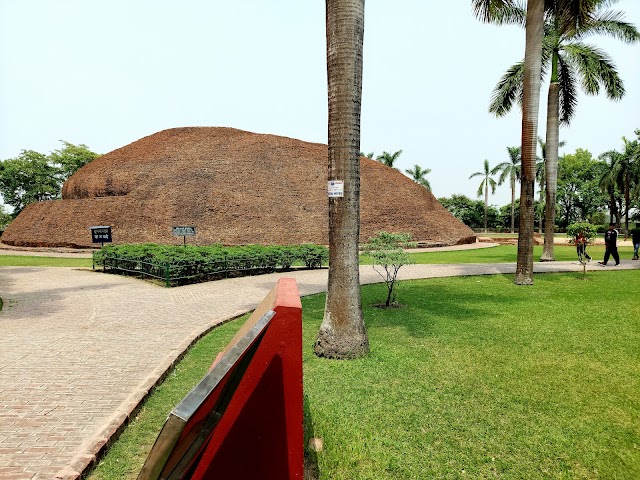Ramabhar Stupa
KushinagarIncredible tourist attraction
Overview
Located about 1.5 kilometres to the southeast of the Nirvana Temple, Ramabhar Stupa is also referred to as Mukutbandhan-Chaitya or Mukta-Bandhan Vihar in early Buddhist texts. Buddhists from all over the country visit the place where the stupa sits because it is so sacred. Its layout and architecture show that it is a historic building from a distant past.
Suggested Duration - 3 to 4 hours
What To Expect?
Near the intersection of the Kushinagar-Deoria highway and a mound, you may see this stupa. It is located on a farm with acres of rice, sugarcane, and wheat. A small body of water resembling a pond can be seen nearby as well.
Tips
- This stupa is accessible from 6 AM to 6 PM throughout the week.
- Pay respect to the rites and rituals of the place.
Ramabhar Stupa Overview: The Final Resting Place of Buddha
Ramabhar Stupa (also known as Mukut Bandhan Chaitya) is a crucial Buddhist monument built over Gautam Buddha's ashes on the spot where he was cremated by the ancient Malla people. It is one of the key pilgrimage destinations for Buddhists across the world. The stupa has been built with striking architecture featuring a towering structure and serene surroundings. Visitors come here to pay respect to the final moments of the Lord Buddha's life.
The monument encompasses nearby meditation parks and monasteries, which form a spiritual atmosphere. This place reflects a lot of Buddhist teachings. Over the years, the Ramabhar Stupa has been an essential part of Kushinagar's development as a Buddhist pilgrimage centre. It heavily attracts monks, scholars, and tourists from across the world.
| Ticket Price | There is no Ramabhar Stupa entry fee. |
|---|---|
| Ramabhar Stupa timings | 6:00 AM to 6:00 PM |
| Best time to visit | October to March |
| Ramabhar Stupa is famous for | It is a popular place because of is the same place where Buddha has attained Mahaparinirvana. |
| height | 49 ft. |
| Time Required | Approximately 3-4 hours |
| Popular Nearby Places | Parinirvana Temple, Shaheed Samrak Chaurchaura, Gorakhnath Temple, Wat Thai Temple, Japanese Temple/Burmese Temple, Buddhist Museum/Kushinagar Museum, Vietnamese Temple/Chinese Buddhist Temple, Buddha Museum (Kushinagar Museum), Matakuar Temple, Dalai Lama Bell |
About Ramabhar Stupa History
The existence of Ramabhar Stupa dates back to the Maurya period during the 3rd century BCE. It is the same spot where Lord Buddha was cremated and attained Mahaparinirvana after his death in 483 BC. Over time, the Ramabhar Stupa has evolved into a popular pilgrimage centre, displaying his teachings even after his death.
Nearby Places to Visit
- Parinirvana Temple
- Shaheed Samrak Chaurchaura
- Gorakhnath Temple
- Wat Thai Temple
- Japanese Temple/Burmese Temple
- Buddhist Museum/Kushinagar Museum
- Vietnamese Temple/Chinese Buddhist Temple
- Buddha Museum (Kushinagar Museum)
- Matakuar Temple
- Dalai Lama Bell
How to Reach Ramabhar Stupa, Kushinagar?
- By Air:The nearest Airport to Ramabhar Stupa is in Kushinagar, which is 5 km away and requires a 12-minute drive.
- By Train:Padrauna (23.1 km), Gorakhpur (55.3 km), and Deoria (31.9 km) are the nearest railway stations to the Ramabhar Stupa.
- By Road:You can access public buses and taxis to reach Ramabhar Stupa from Gorakhpur, Deoria, and Kushinagar.
Things to Do At Ramabhar Stupa
- Practice Meditation: This is the cremation place of the Lord Buddha. Hence, it is the best place to practice meditation and experience spiritual reflection.
- Attend Buddhist Rituals: You should witness rituals performed by local monks here, as it would be a great spiritual experience.
- Learn History: You should talk to locals or monks there to gain detailed insights about Lord Biddha's final journey at the Ramabhar Stupa.
- View Sunrise/Sunset: You should watch the sunset/sunrise to experience beautiful lighting and a peaceful atmosphere.
FAQs - Frequently Asked Questions about Ramabhar Stupa
What is special about Ramabhar Stupa?
Where is Buddha buried?
Where is the last place of Buddha?
How do you plan for the perfect trip to any destination?
How to explore a place by yourself?
How to choose a destination to travel to?

